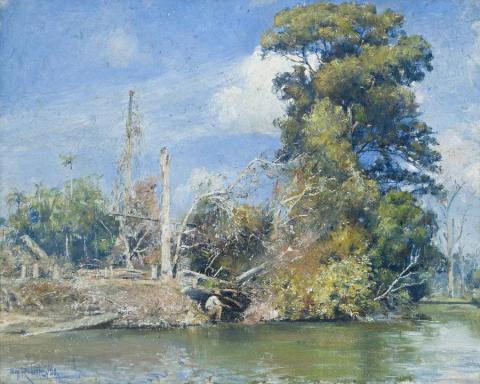AN ISLAND ON THE TWEED, N.S.W., 1920
TOM ROBERTS
oil on canvas on board
35.5 x 45.0 cm
signed and dated lower left: Tom Roberts 20
inscribed with title on partial label verso
Collection of William Bardsley, Melbourne
Thence by descent
Private collection, Melbourne
Recent Work by Tom Roberts, Fine Art Society, Athenaeum Hall, Melbourne, 17–30 September 1924, cat. 26 (partial label attached verso)
McQueen, H., Tom Roberts, Pan Macmillan Australia Pty Limited, Sydney, 1996, p. 628
An Island on the Tweed, NSW, 1920, oil on prepared board, 19.4 x 30.5 cm, signed and dated lower right:'/20 Tom Roberts'; inscribed verso:'Sugar cane cutting, Queensland', in Topliss, H., Tom Roberts 1856 – 1931: A Catalogue raissoné, Oxford University Press, Melbourne, 1985, vol. 1, p. 196, cat. 501
In the early spring of 1920 Tom Roberts was in northern New South Wales, staying on Dodd's Island in the Tweed River. 'To get stores and collect his mail', wrote Humphrey McQueen in his biography of Roberts, 'he had to row a mile into town, and a mile back. He lived off the cultivated land, savouring fruit salads and cream.'1 The experience was invigorating. Roberts, however, 'regretted the clearing of rainforest to plant sugarcane', vividly presented in his painting An Island on the Tweed, N.S.W. 1920.2 The tall, noble gum tree in the right of the composition stands in dramatic contrast to the destruction of the native forest to the left, the trunks of decapitated trees reaching skywards in, as it were, vain supplication. The metaphoric association of their skeletal appearance and vertical emphasis adds to the painting's emotional appeal, extended through the horizontals of the trees laid low. Roberts was a great admirer of the Australian gum celebrated in all its vertical grandeur in his painting Sherbrooke Forest 1924 in the collection of the Art Gallery of New South Wales. This is apparent throughout his life and work. 'I say, isn't the gum a beautiful and sympathetic tree?', he observed.3 And again, 'Think of the red gums of a Murray flat, how they stretch their arms one to another, they are a great tree, showing all their great construction.'4 Significantly, Roberts included the painting Joy o' Gums in the same 1924 exhibition in which our painting was shown. Roberts shared his concern about the destruction of the native forests, with his old friend Arthur Streeton. This is seen in a number of Streeton's paintings of the Dandenong Ranges, Last of the Messmates 1928 (private collection) with its solitary messmate gum being dramatic testimony of the destruction of the once rich forest.
Roberts often included figures in his landscape paintings. Single or several figures were introduced for a variety of purposes - to humanise the landscape, provide scale, or special focus. In An Island on the Tweed, N.S.W. the man appears to be crouching a little precariously within the shelter provided by the devastation - or is he fishing, living off the land as was Roberts during his sojourn on the island? Roberts was one of the leading pioneers of plein air painting in Australia. In later years the studio had a stronger appeal where, as in our painting, the impressions of the outdoors were skilfully orchestrated into a composition that is unmistakably Australian as man tames the wilderness for his use.
1. McQueen, H., Tom Roberts, Pan Macmillan Australia Pty Limited, Sydney, 1996, p. 627
2. Ibid, p. 628
3. Roberts quoted in McQueen, op. cit., p. 629
4. Ibid, p. 628
DAVID THOMAS
